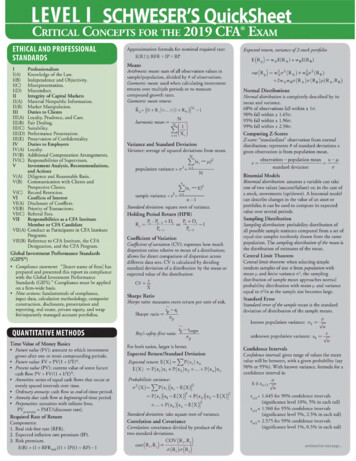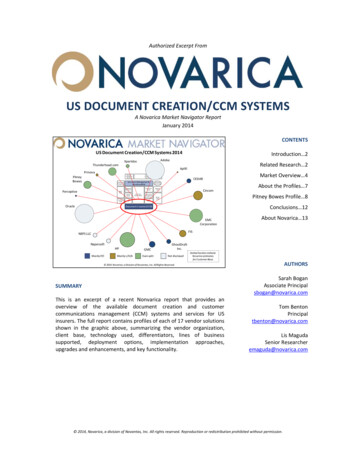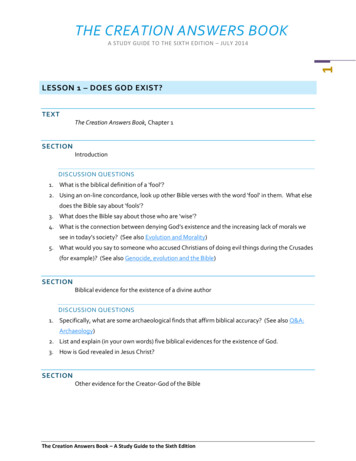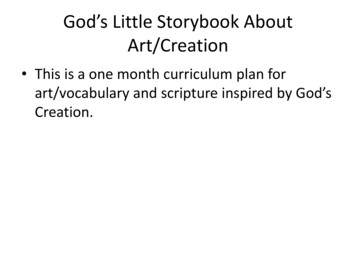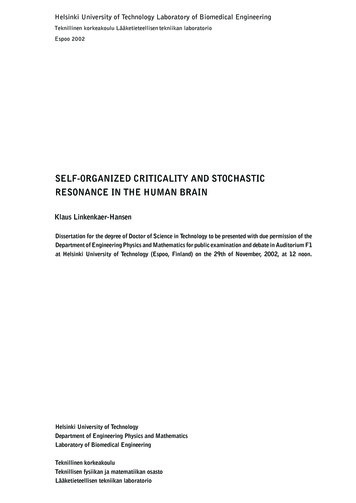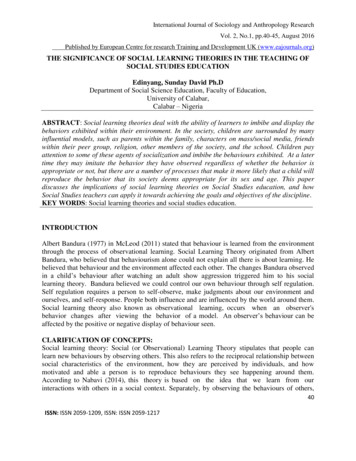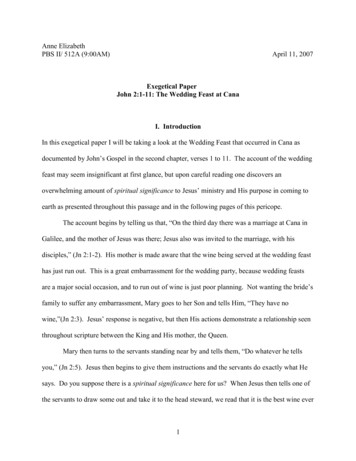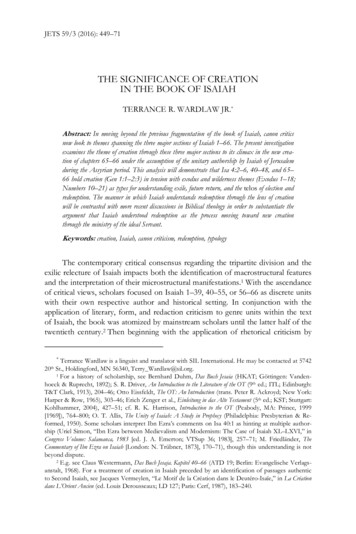
Transcription
JETS 59/3 (2016): 449–71THE SIGNIFICANCE OF CREATIONIN THE BOOK OF ISAIAHTERRANCE R. WARDLAW JR.*Abstract: In moving beyond the previous fragmentation of the book of Isaiah, canon criticsnow look to themes spanning the three major sections of Isaiah 1–66. The present investigationexamines the theme of creation through these three major sections to its climax in the new creation of chapters 65–66 under the assumption of the unitary authorship by Isaiah of Jerusalemduring the Assyrian period. This analysis will demonstrate that Isa 4:2–6, 40–48, and 65–66 hold creation (Gen 1:1–2:3) in tension with exodus and wilderness themes (Exodus 1–18;Numbers 10–21) as types for understanding exile, future return, and the telos of election andredemption. The manner in which Isaiah understands redemption through the lens of creationwill be contrasted with more recent discussions in Biblical theology in order to substantiate theargument that Isaiah understood redemption as the process moving toward new creationthrough the ministry of the ideal Servant.Keywords: creation, Isaiah, canon criticism, redemption, typologyThe contemporary critical consensus regarding the tripartite division and theexilic relecture of Isaiah impacts both the identification of macrostructural featuresand the interpretation of their microstructural manifestations.1 With the ascendanceof critical views, scholars focused on Isaiah 1–39, 40–55, or 56–66 as discrete unitswith their own respective author and historical setting. In conjunction with theapplication of literary, form, and redaction criticism to genre units within the textof Isaiah, the book was atomized by mainstream scholars until the latter half of thetwentieth century.2 Then beginning with the application of rhetorical criticism by* Terrance Wardlaw is a linguist and translator with SIL International. He may be contacted at 574220th St., Holdingford, MN 56340, Terry Wardlaw@sil.org.1 For a history of scholarship, see Bernhard Duhm, Das Buch Jesaia (HKAT; Göttingen: Vandenhoeck & Ruprecht, 1892); S. R. Driver, An Introduction to the Literature of the OT (9th ed.; ITL; Edinburgh:T&T Clark, 1913), 204–46; Otto Eissfeldt, The OT: An Introduction (trans. Peter R. Ackroyd; New York:Harper & Row, 1965), 303–46; Erich Zenger et al., Einleitung in das Alte Testament (5th ed.; KST; Stuttgart:Kohlhammer, 2004), 427–51; cf. R. K. Harrison, Introduction to the OT (Peabody, MA: Prince, 1999[1969]), 764–800; O. T. Allis, The Unity of Isaiah: A Study in Prophecy (Philadelphia: Presbyterian & Reformed, 1950). Some scholars interpret Ibn Ezra’s comments on Isa 40:1 as hinting at multiple authorship (Uriel Simon, “Ibn Ezra between Medievalism and Modernism: The Case of Isaiah XL–LXVI,” inCongress Volume: Salamanca, 1983 [ed. J. A. Emerton; VTSup 36; 1983], 257–71; M. Friedländer, TheCommentary of Ibn Ezra on Isaiah [London: N. Trübner, 1873], 170–71), though this understanding is notbeyond dispute.2 E.g. see Claus Westermann, Das Buch Jesaja. Kapitel 40–66 (ATD 19; Berlin: Evangelische Verlagsanstalt, 1968). For a treatment of creation in Isaiah preceded by an identification of passages authenticto Second Isaiah, see Jacques Vermeylen, “Le Motif de la Création dans le Deutéro-Isaïe,” in La Créationdans L’Orient Ancien (ed. Louis Derousseaux; LD 127; Paris: Cerf, 1987), 183–240.
450JOURNAL OF THE EVANGELICAL THEOLOGICAL SOCIETYJames Muilenburg, and growing to fruition with the emphasis on final-form readingby canon critics, fresh impulses toward canonical readings resulted as scholars suchas Rendtorff, Childs, and Seitz attempted to follow the trajectory of the canonicalpresentation of Isaiah through all 66 chapters in order to identify the overall discourse aim of the final editor within the context of the canonizing community.3However, with this renewed interest in Isaiah as a book there has been no treatment of creation as a major theme within its overall discourse structure, except forthe assertion that references to creation in “First Isaiah” indicate exilic or postexilicredaction.In contrast, quibbling over hypothetical sources and redactions remained aforeign concern to pre-critical exegetes. John Calvin and his Reformation progenyassumed the book of Isaiah was a unity deriving from the hand of the eighthcentury-BC Isaiah of Jerusalem. Moreover, they assumed the prophets in generalderived their doctrine from the Law and declared nothing that is not somehowrelated to the Law.4 The prophets “enter more largely into the illustration of doctrine, and explain more fully what is briefly stated in the Two Tables, and lay downwhat the Lord chiefly requires from us. Next, the threatenings and promises, whichMoses had proclaimed in general terms, are applied by them to their own time andminutely described.”5 Thus, the prophets do not intend to add to the Law, but rather to interpret it faithfully. Foremost, Calvin’s reading assumptions regarding thepriority of the Mosaic Pentateuch and the literary dependence of the prophets upon3 James Muilenburg, “Introduction, The Book of Isaiah Chapters 40–66,” in IB 5.381–419, 422–773;Roy F. Melugin, The Formation of Isaiah 40–55 (BZAW 141; Berlin: de Gruyter, 1976); Peter R. Ackroyd,“Isaiah I–XII: Presentation of a Prophet,” VTSup 29 (1978): 15–48; J. J. M. Roberts, “Isaiah in OTTheology,” Int 36 (1982): 130–43; R. E. Clements, “The Unity of the Book of Isaiah,” Int 36 (1982):117–29; idem, “Beyond Tradition-History: Deutero-Isaianic Development of First Isaiah’s Themes,”JSOT 31 (1985): 95–113; idem, “Isaiah: A Book without an Ending?” JSOT 97 (2002): 109–26; RolfRendtorff, “Zur Komposition des Buches Jesaja,” VT 34 (1984): 295–320; idem, “Jesaja 6 im Rahmender Komposition des Jesajabuches,” in The Book of Isaiah/Le Livre D’Isaïe: Les Oracles et Leurs RelecturesUnité et Complexité de L’Ouvrage (ed. Jacques Vermeylen; BETL 81; Leuven: Leuven University, 1989), 73–82; Richard J. Clifford, Fair Spoken and Persuading: An Interpretation of Second Isaiah (New York: Paulist,1984); Jacques Vermeylen, “L’Unité du Livre d’Isaïe,” in The Book of Isaiah (ed. Vermeylen), 11–53;Marvin A. Sweeney, Isaiah 1–4 and the Post-Exilic Understanding of the Isaianic Tradition (BZAW 171; Berlin:de Gruyter, 1988); Christopher R. Seitz, “Isaiah 1–66: Making Sense of the Whole,” in Reading and Preaching the Book of Isaiah (ed. Christopher R. Seitz; Philadelphia: Fortress, 1988), 105–26; idem, “The DivineCouncil: Temporal Transition and New Prophecy in the Book of Isaiah,” JBL 109 (1990): 229–47; idem,Zion’s Final Destiny: The Development of the Book of Isaiah: A Reassessment of Isaiah 36–39 (Minneapolis: Fortress, 1991); idem, Isaiah 1–39 (Int; Louisville: John Knox, 1993); idem, “How is the Prophet IsaiahPresent in the Latter Half of the Book? The Logic of Chapters 40–66 within the Book of Isaiah,” JBL115 (1996): 219–40; Benjamin D. Sommer, A Prophet Reads Scripture: Allusion in Isaiah 40–66 (Stanford,CA: Stanford University Press, 1998); Brevard Childs, Isaiah (OTL; Louisville: Westminster John Knox,2001). For a redactional analysis of Isaiah as a book, as well as the themes linking various units together,see H. G. M. Williamson, The Book Called Isaiah: Deutero-Isaiah’s Role in Composition and Redaction (Oxford:Clarendon, 1994). In dissent from these approaches, David Carr argues that all of the contents of Isaiahcannot be reconciled within the present macrostructure (“Reaching for Unity in Isaiah,” JSOT 57 [1993]:61–80).4 E.g. John Calvin, Commentary on the Book of the Prophet Isaiah (trans. Rev. William Pringle; Calvin’sCommentaries; 22 vols.; Grand Rapids: Baker, 1998 [1550/1850]), 7.xxvi.5 Ibid.
THE SIGNIFICANCE OF CREATION IN THE BOOK OF ISAIAH451it in conjunction with more recent defenses of the authorship of the entire book byIsaiah of Jerusalem provide a valid foundation for reading the theme of creationacross the critically identified divisions of Isaiah’s discourse structure, and this reading strategy also provides grounds for understanding historical reference in Isaiahalong more traditional lines as presented within the book.6 To this pre-critical andReformation mode of reading may be added more recent advances in identifyingdiscourse structure and literary features.7In particular, the present investigation concerns itself with creation in thebook of Isaiah and the function of this theme in relation to redemption within Isaiah’s overall discourse structure. Previous studies focused on creation either in theso-called Isaian Apocalypse, Second Isaiah, or on new creation in Isaiah 65–66.Moreover, form-critical analyses focused on the relation of creation themes to discrete subunits and their individual Gattungen. Therefore, modern analyses focusedon creation within critically identified exilic or postexilic levels of the text ratherthan within the linear flow of the text’s own narrative world or its wider canonicalsetting taken at face value in accordance with pre-critical and Reformation exegesis.Therefore, the following reading and analysis will demonstrate that Isa 4:2–6, 40–48, and 65–66 hold creation (Gen 1:1–2:3) in tension with exodus and wildernessthemes (Exodus 1–18; Numbers 10–21) as types for understanding exile, the futurereturn, and the telos of election and redemption.8 Although exodus typology in Isaiah has been widely acknowledged, the significance of creation typology has beendiminished with focus placed instead on redemption. This is especially interestingsince Isaiah reappropriated creation traditions alongside exodus and wildernesstypological complexes, and focused upon the climax of new creation in chapters6 J. A. Motyer, The Prophecy of Isaiah (Downers Grove, IL: IVP Academic, 1993); John Oswalt, Isaiah(NICOT; 2 vols.; Grand Rapids: Eerdmans, 1986, 1998); Gary Smith, Isaiah (NAC 15a–b; 2 vols.; Nashville: B&H, 2007, 2009).7 Eep Talstra, Oude en Nieuwe Lezers: Een inleiding in de methoden van uitleg von het Oude Testament(Kampen: Kok, 2002); Christof Hardmeier, Textwelten der Bibel entdecken: Grundlagen und Verfahren einertextpragmatischen Literaturwissenschaft der Bibel (2 vols.; Textpragmatische Studien zur Literatur- undKulturgeschichte der Hebräischen Bibel 1; Gütersloh: Gütersloher Verlagshaus, 2003, 2004); Terrance R.Wardlaw Jr., “Discourse Analysis,” in Words and the Word: Explorations in Biblical Interpretation and LiteraryTheory (Nottingham, UK: Apollos, 2008), 266–317.8 Typology is a mode of historical understanding by which historical persons, events, or institutionsare understood as anticipating those which follow. The type points toward an even greater fulfillment(Steigerung) with the anti-type. See Patrick Fairbairn, The Typology of Scripture: Viewed in Connexion with theEntire Scheme of the Divine Dispensations (2nd ed.; Philadelphia: Smith & English, 1854); Leonhard Goppelt,Typos: The Typological Interpretation of the OT in the New (trans. Donald H. Madvig; Grand Rapids: Eerdmans,1982) (trans. of Typos: Die typologische Deutung des Alten Testaments im Neuen [Gütersloh: C. Bertelsmann,1939]); Bernhard W. Anderson, “Exodus Typology in Second Isaiah,” in Israel’s Prophetic Heritage: Essaysin Honor of James Muilenburg (ed. Bernhard W. Anderson and Walter Harrelson; New York: Harper &Brothers, 1962), 178–80; Richard M. Davidson, Typology in Scripture: A Study of Hermeneutical ΤΥΠΟΣStructures (Andrews University Seminary Doctoral Dissertation Series 2; Berrien Springs, MI: AndrewsUniversity Press, 1981); Daniel J. Treier, “Typology,” in Dictionary for Theological Interpretation of the Bible(ed. Kevin J. Vanhoozer; Grand Rapids: Baker Academic, 2005), 823. For a more recent discussion of“figuration,” see Christopher R. Seitz, Prophecy and Hermeneutics: Toward a New Introduction to the Prophets(Studies in Theological Interpretation; Grand Rapids: Baker, 2007).
452JOURNAL OF THE EVANGELICAL THEOLOGICAL SOCIETY65–66. This focal discourse aim possesses great bearing upon contemporary theological dialogue and ecclesiastical practice, as will be suggested below.I. PREVIOUS DISCUSSIONS OF CREATIONIN SECOND AND THIRD ISAIAHOne of the first historical questions to be answered when approaching the issue of creation within the book of Isaiah is the source and background of references to creation. Although some scholars argue that the creation language in Deutero-Isaiah is closely related to Mesopotamian cosmological language, these worksfail to identify direct phrasal parallels.9 Moreover, they draw conclusions based upon generalizations about Mesopotamian creation texts and the text of Isaiah ratherthan treating linguistic particulars. In contrast, quite a few studies of creation inIsaiah identify the intertextual relationship of creation in Isaiah to Genesis 1–3without making a commitment regarding the direction of influence.10 At the sametime, some scholars depart from blanket applications of Wellhausen’s synthesis ofprophets predating Law and conclude that Priestly traditions antedate propheticmaterials in general, as well as Isaian materials in particular.11 For the present study,as stated within the introduction, it will be assumed that the traditions within Genesis 1–3 reside behind Isaiah’s creation language (e.g. Isa 41:5), alongside poetic andfigurative references to Chaoskampf traditions from ancient Israel’s historical andcultural environment (e.g. Isa 27:1).12 In order to satisfy demands for greater methodological rigor in identifying quotation, allusion, and echo, particular verbal and9 Joseph Blenkinsopp, “The Cosmological and Protological Language of Deutero-Isaiah,” CBQ 73(2011): 493–510; Bernard F. Batto, In the Beginning: Essays on Creation Motifs in the Ancient Near East and theBible (Winona Lake, IN: Eisenbrauns, 2013); Christine Mitchell, “A Note on the Creation Formula inZechariah 12:1–8; Isaiah 42:5–6; and Old Persian Inscriptions,” JBL 133 (2014): 305–8.10 Peter D. Miscall, “Isaiah: New Heavens, New Earth, New Book,” in Reading Between Texts: Intertextuality and the Hebrew Bible (ed. Danna Nolan Fewell; Literary Currents in Biblical Interpretation; Louisville: Westminster/John Knox, 1992), 41–56; Richard L. Schultz, “Intertextuality, Canon, and ‘Undecidability’: Understanding Isaiah’s ‘New Heavens and New Earth’ (Isaiah 65:17–25),” BBR 20 (2010): 19–38.One of the shortcomings of these literary readings is their failure to read Isaiah on the plane of history.Divorced from its historical reference, Isaiah loses its authority and significance for the church today.11 John Day, “Prophecy,” in It is Written: Scripture Citing Scripture (ed. D. A. Carson and H. G. M. Williamson; Cambridge: Cambridge University Press, 1988), 39–55; Odil Hannes Steck, “Der Neue Himmelund die Neue Erde: Beobachtungen zur Rezeption von Gen 1–3 in Jes 65,16b–25,” in Studies in the Bookof Isaiah: Festschrift Willem A. M. Beuken (ed. J. Van Ruiten and M. Vervenne; BETL 132; Leuven: LeuvenUniversity Press, 1997), 349–65; Manfred Görg, “Revision von Schöpfung und Geschichte: Auf demWege zu einer Strukturbestimmung von Jes 40, 1–8(11),” in Ich bewirke das Heil und erschaffe das Unheil(Jesaja 45,7): Studien zur Botschaft der Propheten (ed. Friedrich Diedrich and Bernd Willmes; Würzburg:Echter, 1998), 135–56. Hugh Williamson concludes from his redactional analysis that there are no references to creation within the authentic sayings of Isaiah (Williamson, Book Called Isaiah, 61).12 Even Gunkel concluded that references to Chaoskampf have been divested of their polytheisticconceptualization within the present form of the biblical text (Hermann Gunkel, Schöpfung und Chaos inUrzeit und Endzeit: Eine religionsgeschichtliche Untersuchung über Gen 1 und Ap Joh 12 [Göttingen: Vandenhoeck & Ruprecht, 1895]). Also see Bruce K. Waltke, “The Creation Account in Genesis 1.1–3,” BSac132 (1975): 25–36; J. G. McConville, “Yahweh and the Gods in the OT,” EuroJTh 2 (1993): 107–17;John H. Walton, “Creation in Genesis 1:1–2:3 and the Ancient Near East: Order out of Disorder afterChaoskampf,” CTJ 43 (2008): 48–63.
THE SIGNIFICANCE OF CREATION IN THE BOOK OF ISAIAH453phrasal parallels situated within the contextual activation of the creation theme willbe noted as evidence for the direct literary connection between Genesis 1–3 andIsaiah within the following discussion.In turning to redactional analyses of the text itself, Jacques Vermeylen limitshis analysis of creation in Isaiah to Second Isaiah.13 He begins by identifying theauthentic Second Isaiah oracles concerning creation, and then proceeds to analyzethem.14 Vermeylen identifies the following passages as authentic to Second Isaiah:40:12, 21a, 22–23, 26; 41:2–4; 42:5–6a, 7b; 44:24, 26bαγ, 28a; 45:11aα, 12–13bα;48:13, 14b–15. He concludes that the mention of creation within these passagesmakes the point that the Lord sovereignly uses the Persians as his instruments inorder to establish the order of creation.15 Vermeylen finds that the use of creationin Second Isaiah relates to the political order. This is not spoken to the exiles, butrather to those living in Judea between 539 and 530 BC in order to rally support forCyrus, who was master of the region.16 Vermeylen summarizes the relation betweencreation and salvation in history as follows. Originally, the text speaks of an orderestablished by Cyrus. Then the second redaction consists of a book of consolationin which there is a reconstitution of the people of Israel as the faithful people ofthe Lord. The final redactor appeals to mythical categories of a victory “on thatday,” which is sacral time.17Following Vermeylen, Christian Streibert sought to compare and contrast twoexilic and post-exilic sources related to Israel’s creation traditions in his 1993 formcritical investigation of creation in Deutero-Isaiah and the Priestly document. 18Streibert worked under the assumption that Isaiah 40–55 consists of independentunits either deriving from Second Isaiah or collected and edited later. In terms ofthe traditions received within these genres, Streibert concluded that the most frequently occurring tradition is the exodus tradition: just as the Lord led Israel fromEgypt, he now leads Israel from Babylon.19 Deutero-Isaiah selected particular traditions, reinterpreted them, and ordered them in the service of his message of salvation.20 Accordingly, mention of creation is not found in discrete units in Isaiah aswithin P and J. Rather, creation is one part of the message of larger units.21 Moreover, Streibert examines the mention of creation in Isaiah 40–55 based on the genrecategory of the occurrence. He follows standard form-critical categories and separates the genres into polemic Gattungen (disputation and judgment oracles), oracles13 Jacques Vermeylen, “Le Motif de la Création dans le Deutéro-Isaïe,” in La Création dans L’OrientAncien, 183–240.14 Vermeylen, “Le Motif de la Création,” 188–212.15 Ibid., 237–38.16 Ibid., 217–20.17 Ibid., 239–40.18 Christian Streibert, Schöpfung bei Deuterojesaja und in der Priesterschrift: Eine vergleichende Untersuchung zuInhalt und Funktion schöpfungstheologischer Aussagen in exilisch-nachexilischer Zeit (BEATAJ 8; Frankfurt amMain: Peter Lang, 1993).19 Streibert, Schöpfung bei Deuterojesaja, 17.20 Ibid., 18.21 Ibid.
454JOURNAL OF THE EVANGELICAL THEOLOGICAL SOCIETYof salvation, songs of praise, oracles of the Lord, and various other smaller genres.22 Within the genres of disputation and judgment, references to creation emphasize the greatness, power, and incomparability of the Lord.23 This theology of creation influenced Isaiah’s monotheistic outlook, whereby only the Lord manifestedhimself as the universal Creator.24 Both P and Deutero-Isaiah emphasize that Godis not merely God of the land. Rather, God’s might encompasses the entire world.25One may conclude that Vermeylen’s reading is overly atomistic, and its assumptions regarding exilic authorship lead to wrong inferences regarding the initialhistorical audience and discourse aim of the text. Rather than the text of Isaiah 40–48 calling late-monarchic Judah and Jerusalem to repent and presenting a messageof hope to future generations undergoing judgment that is based on the fulfillmentof past prophecy, Isaiah has become a political document in the service of the Persians. As a result, Vermeylen flattens the text and misses the theological import of aprescient, prophetic message which points toward the omniscience and omnipotence of the Creator. One may evaluate Streibert’s work similarly.II. THE EMERGENCE OF CREATION WITHIN ISAIAHWe now turn to an examination of the manner in which the theme and vocabulary of creation emerge within the linear structure of the Book of Isaiah. Thisinvestigation will argue that creation builds from its introduction alongside wilderness and tabernacle imagery in Isa 4:2–6, to its integration with the themes ofjudgment and redemption in chapters 40–48, and then climaxes with new creationin chapters 65–66. This final climax of creation suggests the prominence of thetheme within the book’s structure and message; however, section III will note themanner in which previous discussions downplay or ignore creation in relation toredemption. These previous discussions focused on redemption and failed to integrate the particulars into an overarching view of judgment and redemption as creative acts culminating in the goal of new creation.Moreover, this investigation will assume that the emergence of a lexical fieldcharacteristic of Genesis 1–3 justifies the identification of a genuine allusion tocreation. 26 In addition, the use of a single semantically-laden word from Israel’sIbid., 19–39.Ibid., 22.24 Ibid., 26.25 Ibid., 98.26 For more on criteria for identifying allusion and echo, see M. Fishbane, Biblical Interpretation in Ancient Israel (Oxford: Clarendon, 1985); Benjamin D. Sommer, A Prophet Reads Scripture: Allusion in Isaiah40–66 (Stanford, CA: Stanford University Press, 1998), 20–22, as well as the works cited in Jeremy M.Hutton, “Isaiah 51:9–11 and the Rhetorical Appropriation and Subversion of Hostile Theologies,” JBL126 (2007): 271–303, esp. pp. 275–78. For an example of identifying allusion within the book of Isaiah,see H. G. M. Williamson, “Isaiah 62:4 and the Problem of Inner-Biblical Allusions,” JBL 119 (2000):734–39. For methodological discussions of quotation and allusion in Isaiah 40–55, see Patricia TullWilley, Remember the Former Things: The Recollection of Previous Texts in Second Isaiah (SBLDS 161; Atlanta:Scholars’ Press, 1997) and Richard L. Schultz, The Search for Quotation: Verbal Parallels in the Prophets(JSOTSup 180; Sheffield: Sheffield Academic, 1999). Exact verbal parallel situated within a correspond2223
THE SIGNIFICANCE OF CREATION IN THE BOOK OF ISAIAH455traditional materials (Leitwort) also qualifies as a reference to the larger tradition andits semantic Gestalt, pars pro toto, in bringing creation typology to bear on Isaiah’smessage of judgment and redemption within a given unit.27 This identification ofsingle significant words remains justified in the light of the numerous overt references to creation throughout the book of Isaiah and the focal climax on creation inchapters 65–66, which indicates that creation is activated in Isaiah’s field of discourse. Such traditional creation language has been identified previously by Wardlaw in Conceptualizing Words for “God” within the Pentateuch.28 Finally, this reading willassume the standard divisions of Isaiah into chapters 1–39, 40–55, and 56–66.1. Judgment and hope in Isaiah 1–39. Allusions, echoes, or references to creationor the Creator may be found in Isa 4:2–6; 13:19; 17:7; 27:1, 11; and 37:14–20.However, discussion will be restricted to Isa 4:2–6 as an exemplary passage since itis programmatic for all which follows.Within Isaiah’s vision concerning Judah and Jerusalem in chapters 2–12 onefinds the first allusion to creation alongside exodus-wilderness typology within 4:2–6. Similar to the disjunctive use of the verb ָבּ ָרא in Num 16:30 in relation to judgment, the disjunctive use of this tradition-laden verb in relation to tabernacle andwilderness terminology in Isa 4:5–6 constitutes a significant lexical occurrence. Thisinitial interweaving establishes the relationship between exodus and creation typology for everything which follows throughout the book. This unit presents a visionof future hope following judgment. “On that day” the branch of the Lord will befor beauty and glory (v. 2), all the holy remnant registered for life will remain inJerusalem (v. 3), and the Lord will wash the filth of the daughter of Zion with aspirit of judgment and burning (v. 4), which resonates with the thematic movementfrom judgment to re-creation found in Genesis 6–9, 18–19, and Exodus 1–15.Then in v. 5 the Lord declares that he will “create” ( )בּ ָרא ָ a cloud by day over everydwelling and gathering place, and fire by night as a canopy. Thus, just as the fireand cloud signified divine guidance and protection in the exodus-wilderness traditions, they now emerge in Isaiah as symbols of God once again guiding and protecting the elect after judgment (Isaiah 2–4).29 However, the integrity of the MT hasbeen questioned on the basis of the LXX reading ἥξει (equivalent to Hebrew )ובוא for MT וּב ָרא ,ָ and the BHS critical apparatus suggests this reading.30 Nevertheless,both Targum Jonathan and the Vulgate agree with MT “create” over LXX “Hecame.” Therefore, in the absence of stronger manuscript evidence, MT is to being thematic structure seems to be a common methodological requirement for establishing a true literaryconnection between two texts. Accordingly, the following discussion will note the correspondence ofvocabulary between the books of Isaiah and Genesis in passages where the theme of creation emerges.27 Terrance R. Wardlaw Jr., Elohim within the Psalms: Petitioning the Creator to Order Chaos in Oral-DerivedLiterature (LHBOTS 602; London: Bloomsbury, 2015), 16–38.28 Terrance R. Wardlaw Jr., Conceptualizing Words for “God” within the Pentateuch: A Cognitive-Semantic Investigation in Literary Context (LHBOTS 495; New York: T&T Clark, 2008).29 John N. Oswalt, The Book of Isaiah: Chapters 1–39 (Grand Rapids: Eerdmans, 1986), 148–49; Christopher R. Seitz, Isaiah 1–39 (IBC; Louisville: John Knox, 1993), 41–42; Gary V. Smith, Isaiah 1–39 (NAC15a; Nashville: B&H, 2007), 158.30 R. E. Clements, Isaiah 1–39 (NCBC; Grand Rapids: Eerdmans, 1980), 54.
456JOURNAL OF THE EVANGELICAL THEOLOGICAL SOCIETYpreferred over LXX. Moreover, Watts notes that “to come” is frequently related tocloud and fire in the OT; however, the subject here is protection rather than theophany, which supports the MT over against LXX.31Although commentators note the connection between the verb “create” anddivine action, they tend not to identify this verb as an allusion to Genesis 1.32 However, just as creation language emerges in the Flood Narrative (Genesis 6–9), thenarrative of Sodom and Gomorrah (Genesis 19), and in the Egyptian Plagues (Exodus 6–14) suggesting that judgment is the first step in God’s act of re-creating asinful world by destroying the wicked and preserving the elect, creation in Isa 4:5 islinked to God protecting and guiding Zion following the judgment of the wicked.33Brevard Childs’s identification of creation through judgment and a return to thefruitfulness of paradise remains a notable exception among critical commentators,although he identifies the allusion as the general eschatological theme of the returnto paradise or Israel’s general traditions rather than to Genesis 1 in particular.34 Theuse of the Leitwort ָבּ ָרא in conjunction with other Pentateuchal themes, however,suggests an intentional allusion to the creation tradition found in Gen 1:1–2:3 rather than an allusion to other ANE creation traditions or to general Israelite creation traditions. Therefore, this occurrence near the beginning of Isaiah establishesfrom the outset that references to creation and related themes in Isaiah 27, 40–48,and 65–66 should be read in the light of Gen 1:1–2:3.35Moreover, the reference to the cloud by day, fire by night, and a booth forprotection echoes the pillar of cloud by day and fire by night from the exodus andwilderness complexes (Exodus–Numbers) as types pointing toward the Lord’spresence and protection among the elect during the imminent work of restorationculminating in the new creation of Isaiah 65–66. Therefore, this allusion to boththe creation and the exodus-wilderness complexes forms the conceptual frameworkfor linking together the prophetic antitype of second exodus and creation throughjudgment outlined in chapters 40–66. Calvin rightly applies this unit to the churchand notes that it is precisely through judgment that the Lord purifies the church,and the fire and canopy connote guidance and protection for the elect today untilthey reach their journey’s end.36 Moreover, Beuken identifies this act of purificationin 4:2–6 as an act of creation whereby Zion is transformed after the pattern of Sinaias the place where God reveals himself and gathers his people.37John D. W. Watts, Isaiah 1–33 (WBC 24; rev. ed.; Nashville: Thomas Nelson, 2005), 74.For example, Motyer, Isaiah, 66. Willem A. M. Beuken identifies this verb as anticipatory to thetheme of creation in Second Isaiah on the literary and redactional level, yet he fails to relate its occurrence to creation themes from other Israelite traditions (i.e. Genesis 1; Jesaja 1–12 [HThKAT; Freiburg:Herder, 2003], 127).33 For the identification of creation language within these texts, see Wardlaw, Conceptualizing Wordsfor “God” within the Pentateuch, 209–12, 215–23, 239–49.34 Brevard S. Childs, Isaiah (OTL; Louisville: Westminster John Knox, 2001), 35–36.35 Marvin Sweeney observes the connection between creation and exodus-wilderness traditions inIsa 4:5–6 and the creation language of chaps. 40–55 (Isaiah 1–4, 179).36 Calvin, Isaiah, 1.151–59; similarly Smith, Isaiah 1–39,
In particular, the present investigation concerns itself with creation in the book of Isaiah and the function of this theme in relation to redemption within Isai-ah’s overall discourse structure. Previous studies focused on creation either in the so-called Isaian Apocalypse, Second Isa

